Comets have been full of mystery since ancient times. In ancient China, comets were often considered unlucky, so they were also called "broomstars". Of course, now we know that a comet is a "dirty snowball" composed of frozen ice blocks such as water, ammonia and methane and many solid dust particles. When approaching the sun, comets decompose into cometary heads and tails under the action of solar radiation, like brooms.
Whenever beautiful comets appear in the sky, have you ever thought about observing comets closely or even landing on comets?
Scientists, like us, want to observe comets closely and land on them to find out. In fact, they not only want to do so, but also have taken action.
That's NASA's Rosetta mission. It is the first mission to visit a comet.
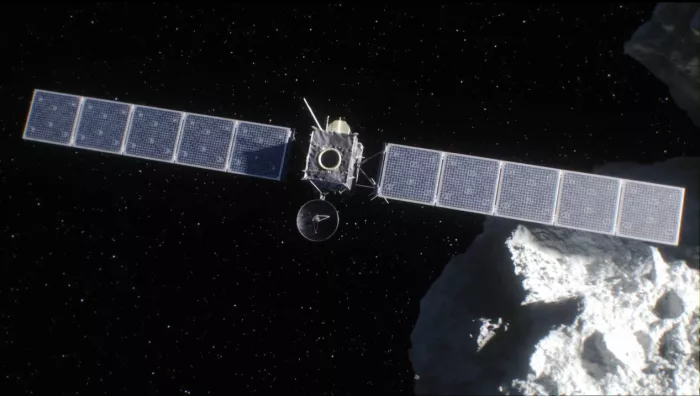
Rosetta detector
From a scientific point of view, comets are more precious than pure gold because they are the real space-time capsules of the solar system. They preserve the chemicals and environment that formed our solar system. They also hold clues to how the chemicals that make up our life reach the earth
Comets are one of the most valuable scientific treasures in existence. However, it is not easy to find a comet suitable for research.
In order to find suitable comets, scientists have demonstrated many comets, which is a bit like a comet "talent show".
When a comet comes in, it seems that it can, oh, orbit can't; Well, this orbit is OK, but it is not what scientists want; Oh, this is too big; This is too small; This is too active
What scientists really want to see is the comet from the outer part of the solar system. As they approach the sun, they heat up, then bypass the sun, and then turn around and return to the outer solar system.
So you need to find a suitable orbit in the solar system and catch the comet on its way in. Finally, scientists finally found a suitable comet: Comet 67p.
Comet 67p has a revolution period of 6.5 years. Its orbit does not make it far from the sun, but only to the orbit of Jupiter. Because its revolution period is not long, scientists have more opportunities to reach the orbit of the comet and successfully rendezvous with it.
The target of the Rosetta mission is only about 3.2 kilometers wide. This target is not only "small", but also a moving target. Comet 67p travels through the solar system at about 53000 kilometers per hour
So to "grasp" this small target, its accuracy is incredible, just like hitting a golf ball from New York to San Francisco and making a hole in one shot.
However, capturing comet 67p is not a simple launch. The speed of the spacecraft must be the same as that of the comet. However, the current propulsion system cannot achieve this goal by flying directly to the comet.
So "Rosetta" carried out a catapult operation, which took 10 years. What it actually does is take some energy away from the planet, that is, it slows the planet down a bit, and then transfers this energy to the detector
When "Rosetta" flew over Jupiter, nearly 160million kilometers away from the warm sun, it entered the most dangerous part of the journey - dormancy.
Although the Rosetta is equipped with solar panels, it still has to sleep. The reason is that it must track the 67p as it flies to the sun. So for the Rosetta spacecraft, all it needs to do is wait quietly.
It is normal to put the spacecraft into body sleep, but scientists are still very worried about the "Rosetta" situation. Because the probe has never been dormant for that long before.
The 31 month dormancy gave the "Rosetta" team enough time to worry about possible problems. It is dark and cold in space. There are many things happening.
On january20,2014, after drifting in space for nearly 10 years, the "Rosetta" should finally wake up, restart the communication system and call home
At this moment, scientists were very nervous. They were afraid that they would not receive the "Rosetta" phone, and that it would sleep forever in space.
When the peak appeared on the chart, the scientists' suspense was finally relieved. Rosetta began sending back images of its targets. At first, it was far away, just a small dot. After a few months, the comet slowly became clear.
[comet 67p is an ugly duckling]
The comet is crystal clear. As it gets closer, scientists see more and more details. Then things began to get very strange.
Scientists thought 67p should be something in the shape of a potato, but the image shows something in the shape of a rubber duck. This strange shape caused trouble for Rosetta.
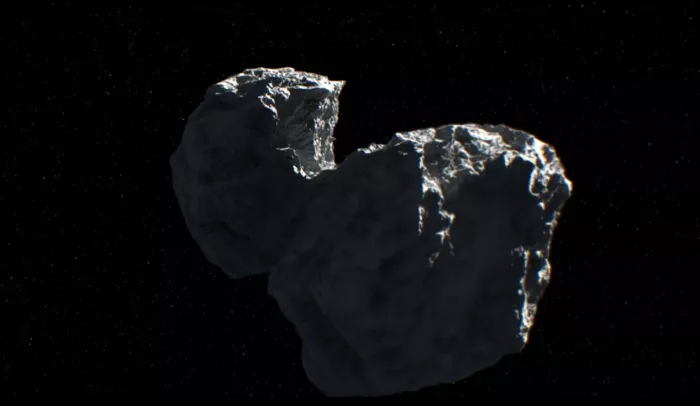
Comet 67p
Orbiting a comet is much more difficult than anyone imagined. If you orbit a planet, the planet has a lot of gravity, so you can send the spacecraft there, and then use the rocket to make it a little slower, and then it will fall into orbit.
But for comet 67p, you are facing a very small rock. The spacecraft could not feel the gravity of the rock
So engineers need to draw their own trajectory, which is a very complex set of motions. Once in orbit, Rosetta can start working.
Its first task is to figure out how 67p was formed, that is, how did the comet form this strange shape?
At present, there are two main points of view: first, its center has been eroded, so it was a more spherical thing at first, and became today's shape through some unknown processes.
Another view is that it started as two separate objects. Space rocks usually collide violently with each other. Their average collision speed is more than 17000 kilometers per hour, which is five times faster than rifle bullets. 67p may be related to the serial collision?
The clues come from different layers on the surface of comet 67p, which is a bit like an onion layer. If you see them in a row, it means that perhaps the object was formed as a single entity, but was later eroded into its present form.
But if you see these layers misplaced, as we see on comets, this is a big clue. It shows that it was originally formed by two independent objects, and later adhered together to form the comet we see today.
Finally, the layers on comet proved that 67p was originally fused by two separate objects**
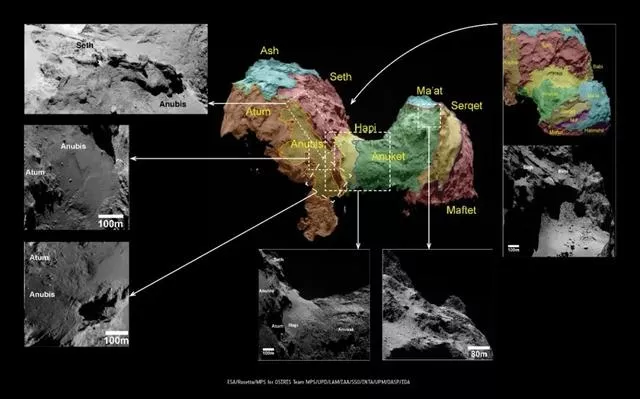
Rosetta partitioned comet 67p surface

The dumbbell shaped small objects formed by erosion and impact should have completely different stratigraphic distribution. Drawing: haibaraemily
It is important to know that comet 67p is composed of two different parts. Because it can tell us what happened in the early solar system.
So as far as we know, these two independent objects must be formed in the same area. They are very similar in composition, but they are very light and fluffy**
If they collide quickly, they will destroy each other. But if they collide at a low speed, they will stick together like two wet snowballs, forming the "ugly duckling" shaped comet 67p we see now
[water on comet 67p]
With a puzzle solved, "Rosetta" began to study the chemical composition of 67p. This little comet can answer one of the biggest questions in planetary science. Where does the water of our blue planet come from?
This comet is a remnant of the formation of the solar system itself. Therefore, this is an opportunity to open the time capsule for scientists to have a glimpse of the ancient solar system.
One of the biggest mysteries about the earth is where water comes from?
Today, water covers two-thirds of the earth's surface. But this was not the case with the early Earth. 4.6 billion years ago, the interior of the solar system was covered with a large number of rock fragments, and the temperature was very high. The early water on the earth evaporated. The evidence tells us that the water on the earth arrived after the formation of the earth.
Scientists believe that the main mechanism is comets. Because comets are basically big snowballs of ice and dust.
One of the main goals of the Rosetta mission is to analyze the water on the comet to see if it matches the water on earth.
Comets come from the two outermost regions of the solar system, the Oort cloud and the Kuiper belt. The Kuiper belt lies on a plane of our solar system, and Pluto, as most people know, is in it.
The Oort cloud is a spherical ice body. It is a library of comets. The distance from the sun is hundreds of thousands of times farther than the distance from the earth to the sun. It is a huge globular cloud that surrounds the sun.
For many large comets, this is a state of deep freezing. Billions of frozen celestial bodies are operating safely outside the chaos of the solar system. They lock up the original water.
For more than four billion years, comets may have done nothing until their orbits changed. Perhaps the gravity of the planets changed everything. Suddenly, they came to a road to the sun. Billions of years of deep frozen ice began to heat up.
Astronomers believe that the former home of comet 67p was the Kuiper belt until something pulled it into the inner solar system. As for what it is, scientists believe that the most likely thing is the bully Jupiter**
Jupiter is a huge planet. It attracts comets and pulls them into the solar system.
At present, 67p has a 6.5-year orbit around the sun. It travels as far away as Jupiter and as close as Mars. As it approached the sun, its frozen ice began to heat up, leading to a famous effect - the comet's tail.
The sun shines on the surface of the comet and heats it, and then the heat is transferred to the inside of the comet. There is a lot of ice there, so the ice is heated, and then the ice evaporates and reaches the surface of the comet. Once on the surface of the comet, the solar wind will bombard the comet. It will strip all the material from the comet and form a beautiful long tail **
Rosetta flew into its tail and analyzed the water vapor. The results show that it is of the same type as the water on the earth.
There are indeed different types of water. The type here does not mean that water is salt water or fresh water, but what it is composed of, that is, its molecules.
Although water molecules are composed of two hydrogen atoms and one oxygen atom, the proton of the hydrogen atom that makes up water may have an additional neutron, which we call deuterium [d ā o]。 So such water molecules are heavier than ordinary water molecules. Such water molecules are also called heavy water.
On earth, the proportion of water is about 160 heavy water molecules than 1million ordinary water molecules.
Rosetta measured the ratio of hydrogen to deuterium in the water vapor as it moved around the comet. A precise match with the earth's proportions would confirm that comets are the source of the oceans.
But Rosetta found something surprising, the ratio of deuterium to hydrogen is three times that of water in the earth's oceans. This means that comets like 67p cannot be the source of water on earth**
If the measurement results are the same as those of seawater, we can say that these comets may be the water transport mechanism we see on earth.
But it is three times higher, which shows that comets like 67p are not the source of the water we see on earth today.
However, although comets like 67p do not provide water to the earth, we cannot exclude all comets. Comets have different series, which have different components. So maybe some comets have water similar to the earth. They bring water to the earth.
[organic compounds on comet 67p]
After analyzing the water, Rosetta began to look for the elements that make up life - basic organic compounds.
Scientists have long believed that comets may carry organic matter, but this could not be confirmed before the Rosetta.
Rosetta detected aliphatic compounds, an organic substance rich in carbon and hydrogen. This is the first time that this substance has been detected on the surface of a comet.
These materials are the raw materials for making proteins. Protein is necessary for all life. This indicates that these substances may have been sent to the earth by comets.
The view that comets carry the cornerstone of life in the entire solar system is called molecular biogenesis. When comets formed in outer space, all these substances formed with them. Then comets bring them to earth, like space trucks. Of course, we don't want these delivery trucks to deliver to our door again.
Now there is another question: where do comets get these ingredients?
The answer may lie deep in space. The floating matter between the star system and the galaxy is called the interstellar medium.
Scientists analyzed the overall composition of comet 67p and found that some of its components were very similar to the two substances found by scientists in the interstellar medium. These materials float in the gas and dust between stars.
If this organic chemistry is common on earth, it is likely to be common throughout the galaxy. That is, this chemical tool for making life is universal. So life itself may be universal. With this universal chemical toolkit, there may be a lot of wet rocks in the space full of life
Therefore, if there are extraterrestrial life, it is very likely that the basic chemicals that make up them are similar to those of life on earth
However, scientists cannot find the origin of another important element in interstellar matter - phosphorus.
Phosphorus is one of the necessary atoms for life and an important component of DNA, cell membrane and energy production.
Scientists have never known where it came from. It is rare in the universe and on the earth's surface.
At the beginning of the earth's birth, any phosphorus around it was locked in soluble rocks, so life at that time could not use it.
If the rock has locked in all the mineralized phosphorus, where does the phosphorus required in the biological process come from?
Comet 67p gave scientists the answer, the biologically available phosphorus was found on comet 67p, and it is not only mineralized phosphorus**
But where did comet 67p get its phosphorus?
In January, 2020, the astronomer compared the data of the "Rosetta" mission with the observation data of the star forming region afgl 5142 by the Atacama millimeter / submillimeter wave array telescope (ALMA).
Afgl 5142 is the cradle of a star. It is an air mass where large and small stars are born at the same time. It is very close to us.
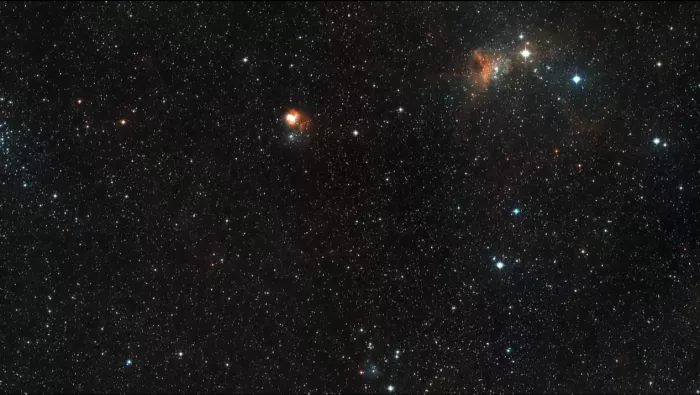
Star forming region afgl 5142
Of course, this "near" is "near" in the astronomical sense. In fact, this air mass is thousands of light-years away from us.
But scientists can already study it in detail. Alma Observatory took high-resolution images of different types of dust and gas very, very close to a newly formed star.
So we can see what happens during the formation of stars. The largest star lives are squandered quickly, so it dies early, and then dies in a supernova explosion.
So scientists believe that phosphorus is formed in massive stars. So essentially, a star is created until the end of its life. When the star becomes a supernova, it ejects phosphorus into the interstellar medium.
When middle sized stars burst out of life, they will send shock waves and radiation to the nebula to convert phosphorus into a form that can be used by organisms - phosphorus monoxide
Phosphorus monoxide freezes on the icy dust particles around the star. These dust particles can gather together to form pebbles and rocks, and eventually comets become transporters of phosphorus monoxide
Scientists track the cosmic trajectory of phosphorus and organic matter, from stars to comets to planets to life. In theory, at least, they can use the chemicals found in comets to build cells.
Many times, people seem to think that astronomy studies very distant things and has nothing to do with our daily life. This is not the case. Astronomy is closely related to each of us.
Since human civilization, we have been exploring three major propositions: "who am I? Where do I come from? Where do I go?" Astronomy has been devoted to the study of these three propositions.
To study the composition of life is to find our own origin, that is, "who am I?"; The beginning of studying the universe, the Milky way, the solar system and the earth is to look for "where do I come from?" Answer to; To study how the universe, the Milky way, the solar system and the earth will end is to look for "where am I going?" Answer to.
[landing on comet 67p]
The next stage of the Rosetta mission is to send the lander to the surface of the comet. This will be the first historic landing on the surface of a comet.
One of the biggest challenges of placing the philai lander on the surface of a comet is not knowing what the surface of the comet is like. Will it be as hard as rock or ice? Will it be crisp?
The designer designed a harpoon for philai, which can poke into the soft surface of the comet. In addition, there is a propeller on the top to prevent it from bouncing from the comet.
However, during the landing, there was a problem. The landing gear of the spacecraft was broken. The lander team found that both systems were not working properly.
They decided to land even though the odds were slim "Philae" slowly declined by 19 kilometers and lasted for 7 hours When the scientists received the first signal of landing, they all breathed a sigh of relief... The lander has landed.
But then they realized that things were not going exactly as planned, and the data of the lander was intermittent. The only possible explanation is that " " Philly "is rolling over and over again. It may have been bouncing all the time, falling on the comet and bouncing into space**
After 12 minutes, there was a glimmer of hope. The lander sent data back according to the procedure. The lander stopped rolling, but Philae's solar panels were not fully operational. This means that there is not enough power for philai to complete all the remaining work.
The battery of this mini spaceship has only 60 hours of power left, which is a race against time. Scientists must abandon all previous plans completely, and then rewrite all the plans, hoping to get the maximum scientific return within that 60 hours
Philae began to work. For the first time, he found that the surface of the comet was stranger than expected. The top 40 cm of comet surface is a very fluffy material. Its density is not high and there are not many rocks... It is very soft. You can imagine something like cigar ash. Its strength is only a small part of polystyrene foam.
Philae's bouncing landing helped scientists investigate the surface on the other hand. By bouncing, scientists can actually sample two points. What is interesting is that the two points are different.
This tells scientists that comets are not uniform and the materials are not exactly the same Philai's instrument shows that comet 67p is not only the fusion of two lobes, but also the aggregation of different blocks under the action of gravity
The camera on philai also provided important clues to the final resting place of the lander.
The photos taken by the lander are really amazing, because from these photos, scientists can actually determine that "Philae" is on its side.
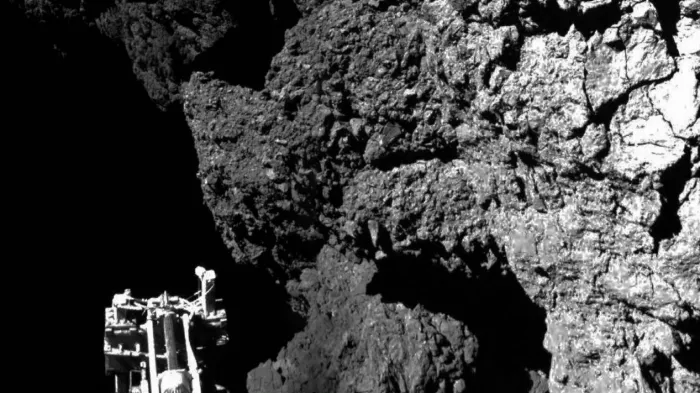
Photos taken by philai Lander
But the location of Philae is unknown. It is far from the planned landing site. Before long, the battery of "Philae" ran out of power and could not communicate with "Rosetta".
If you don't know the exact location on the comet's surface, you will have a problem. Some instruments need to know the exact location to really interpret the data. Without this information, the results will be meaningless.
When Rosetta scanned the comet for the missing lander, it faced a new problem. When the dirty snowball rushed to the sun, the radiation from the sun would heat it, so it began to crackle and deform. It's like a fireworks show, where huge air streams eject material from the earth's surface.
When Rosetta scanned the comet for the missing detector, it flew about 3 kilometers from the surface of the comet, close enough to cast a shadow. This distance is enough for Rosetta to smell the surface of the comet.
Rosina instrument allows us to detect the chemical substances of the gas released by comets, so scientists can use them to make comet perfume.
But it's not a pleasant smell. If you can imagine a mixture of things, such as rotten eggs, cat urine, and bitter almonds. And the smell is very pungent and unpleasant.
A few months later, Philae still disappeared. The comet is not very big. Where will it be hidden? If they knew where it was hidden, scientists could better understand the image it returned.
In a sense, "Philae" is like a friend of scientists. So for months, scientists have been trying to find "Philae".
One day, good news finally came. A sharp eyed researcher found something in the corner of the image. The lander is a tiny spot. You have to zoom in to see it. Now "Philae" lies at the bottom of the cliff, lying on the side under a protruding ledge, and in the shadow.
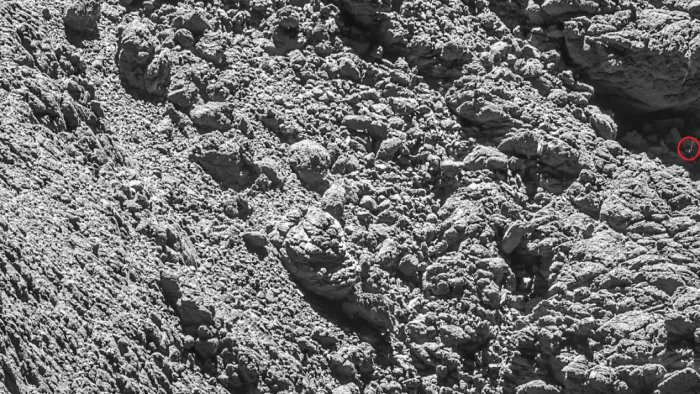
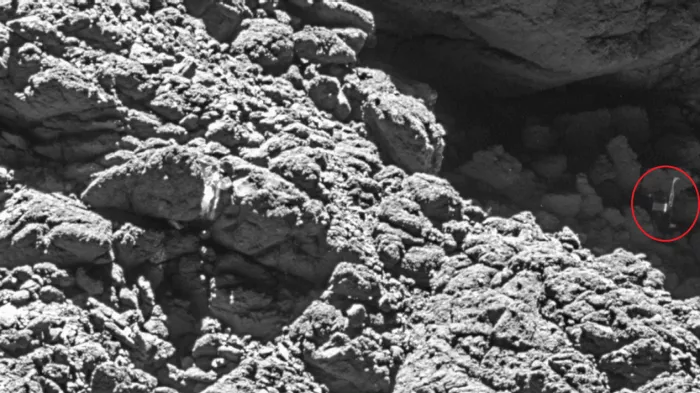
The lost and recovered "Philae"
The location of Philae was determined and a final puzzle was solved: the data sent back a few months ago revealed that this area of the comet was solid.
"Philae" achieved amazing success. Despite these problems, we landed successfully, although the landing looked a little ugly.
It stopped at the bottom of the cliff, and scientists actually got some amazing images and some wonderful data about the gas and structure of the comet itself. If we did not try to put the lander on the comet, we would never get these images and these data.
[mystery of comet 67p's huge jet]
The mission of Rosetta was not over. When the comet approached the sun, chaos broke out. Suddenly, some jet streams appeared and a large amount of material was ejected from the interior.
When sunlight heats the surface of a comet, ice turns directly into gas. The comet's uneven surface turns the escaping water vapor into a narrow jet of gas and dust. But Rosetta also found a huge explosion of violent gas.
Scientists expect to see jets on comets rise and fall as the sun shines. But these outbreaks are completely different. They only rise sharply and then stop. And these bursts are not synchronized with the sun. They appear at random, so there must be another reason.

A huge jet from a comet
These bursts are sudden, short-lived high-speed events. Because Rosetta only takes surface photos every 5 to 30 minutes. When scientists see only one explosion in one image, they know that the whole event lasts shorter than this period of time. This makes scientists feel very mysterious.
When the comet approached the sun, Rosetta's camera captured 34 bursts in just three months, all of which were large. In just a few minutes, a jet stream can release up to 260 tons of material. One jet stream was found to release 40 pounds of material per second
What caused the outbreak?
In September, 2014, scientists found a 230 foot long and 3 foot wide crack on the edge of the cliff in the close-up image of comet 67p. Scientists call this crack Aswan.
Less than a year later, Rosetta captured a large explosion in the same area of the comet. When the probe investigated the area, it found a destroyed landscape. The cliff collapsed in a huge landslide. It's like a crime scene. Scientists have pictures before and after.
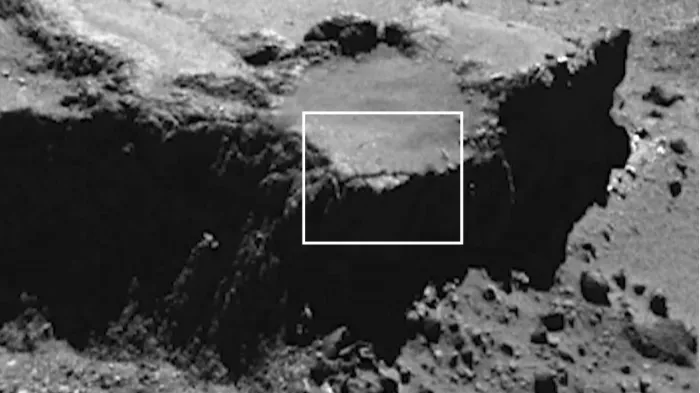
Aswan crack on comet 67p
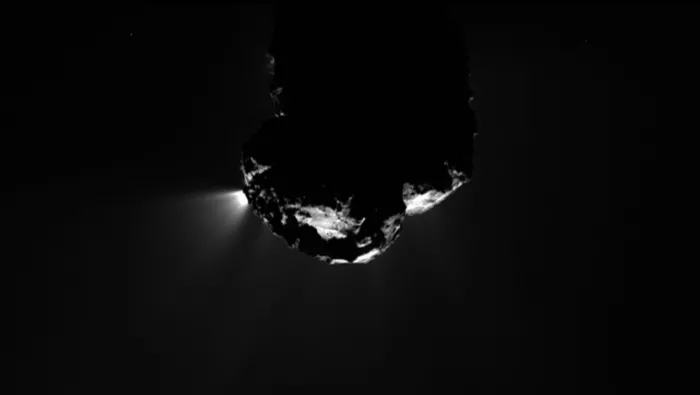
A major explosion in the same area of the "Aswan" fracture
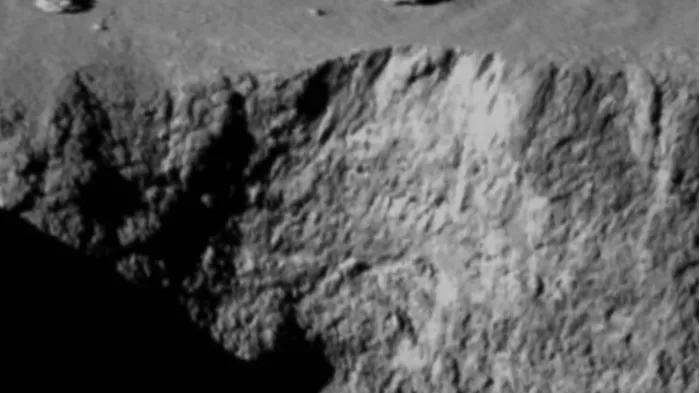
Collapsed cliff
So what is the connection between the explosion and the cliff collapse?
Scientists believe that this is a domino effect. The sun heats up some volatiles deep in the earth's surface, which sublimate and turn into gas. Then any tiny crack or crevice will be emitted from the comet. But this process weakens part of the comet's surface, which releases more material. When a substance is to be ejected from the inside, it will begin to force the gas through a nozzle like function, just like a jet
As the material continuously ejects, it will lead to weaker surface material, which may lead to large-scale collapse, and eventually lead to a huge explosion
Comet 67p reveals the hidden geological activity in these dirty snowballs.
[dunes on comet 67p]
Rosetta discovered another surprising phenomenon: the strange shape of sand dunes moving on the surface.
These are real sand dunes. They are about 6 feet high and extend hundreds of feet in all directions
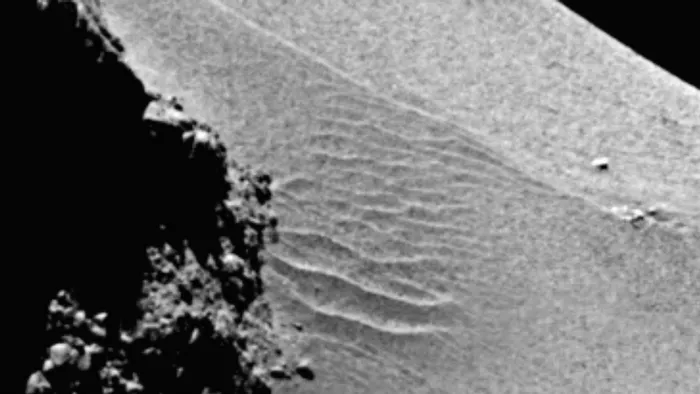
"Dunes" on comet 67p
When scientists first saw these, no one knew how they formed. In fact, scientists even suspect that they are dune like landforms. Because on a celestial body without an atmosphere, let alone with wind, how can they form sand dunes?
On earth, it has a stable, thick atmosphere. It has continuous solar heating. It can collect air masses and move them to the surface to generate wind.
Comet 67p does have an atmosphere, which is formed by the sun heating its surface and releasing gas, but the maximum pressure of this atmosphere is 100000 times lower than that of the earth
Using Rosetta images, French researchers simulated the movement of gas on the surface of comets.
They thought they had found the answer. The researchers found that there was wind on the surface of the comet, and it was short-lived. They form because the gas escapes from the sunny side, and then they rush through the surface to the cold side. This air movement across the surface carries away the sand and forms sand dunes.
The particles on comets are much larger than those on earth. On earth, dunes are composed of very small particles, but on comets, dune particles are the size of table tennis balls.
In the process of moving particles, gravity also plays a very important role. The density of comets is very low. If they walk around, they can easily fly into orbit. So such large but low density particles are easily thrown up by the very thin air there.
[destination of Rosetta]
After two years of orbiting the sun with comet 67p, Rosetta's mission was almost over. The scientists' plan is to land the Orbiter on the surface of the comet in a controlled way. This will make it possible to take very high-resolution images, as well as some gas detection near the surface of comets.
On September 30, 2016, "Rosetta" spent 14 hours slowly falling to the comet in the form of free fall, and took photos during the fall.
With the landing of Rosetta, it touched the surface of the comet, then its contact with the earth was interrupted, and the mission ended.
Now comet 67p has a small part of us. The comet circles Jupiter every 6.5 years. There will always be some human shadow on the comet
Finally, there is an episode in the "Rosetta" story. Scientists thought they had obtained the last image sent back by the Rosetta before the planned mission ended.
But it turned out that just before landing, before the data could be completely transmitted back to earth, an incomplete packet was sent back. But the computer dropped the incomplete packet.
Recently, human experts rechecked the data package, and the results... The recent 67p photos taken by the Rosetta were presented to us.
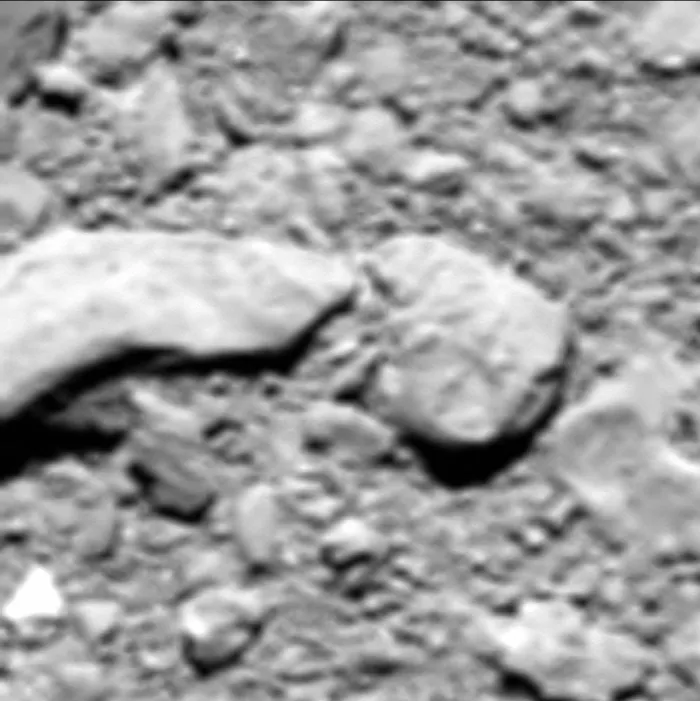
Last photo of the Rosetta mission
This picture is amazing, because when you zoom in and look at it, you will feel that you can really reach out and touch its surface.
The Rosetta mission has changed our understanding of comets and may inspire new missions. Scientists may return to comet 67p again to find out about the origin of our life, and there are still many things to be discovered about ourselves. There are still many things to study and many mysteries to be solved.